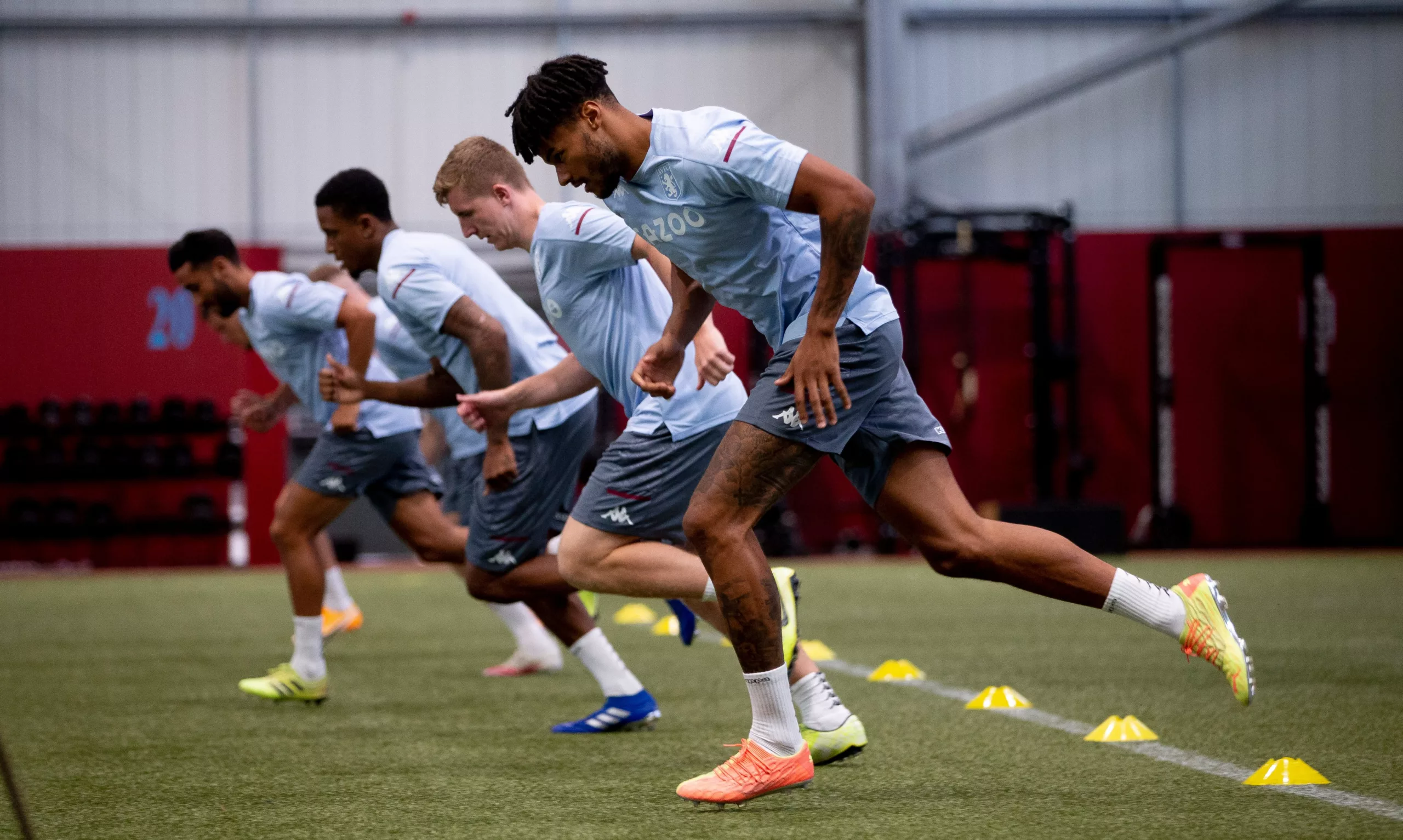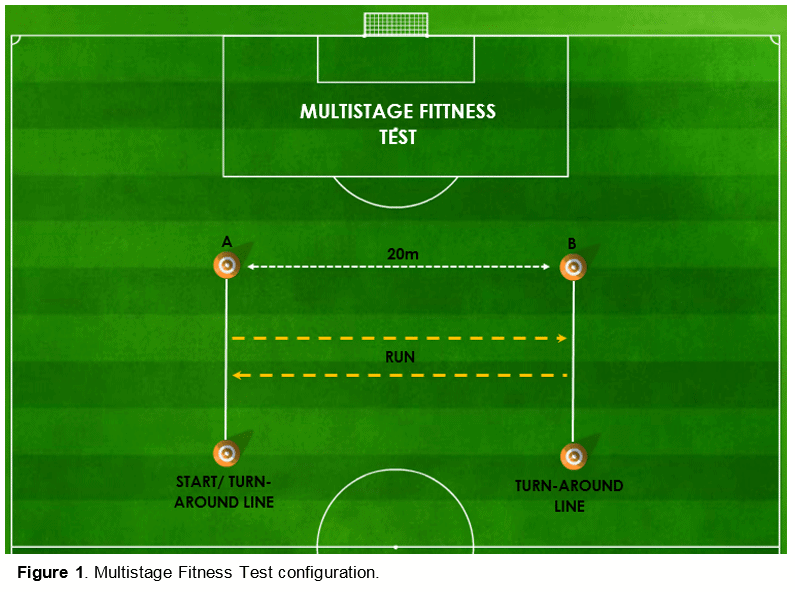Contents of Article
- Summary
- What is the Multistage Fitness (Beep) Test?
- How do you conduct the Multistage Fitness Test?
- How do you score the Multistage Fitness Test?
- Considerations for using the Multistage Fitness Test
- Is the Multistage Fitness Test valid and reliable?
- Are there any issues with the Multistage Fitness Test?
- References
- About the Author
Summary
Developed in the early 1980s, the Multistage Fitness Test was created to provide a cost-effective and practical prediction of maximal oxygen uptake (VO₂ max) in children, adolescents, and adults. Despite becoming the most popular test for measuring aerobic power, recent research has reported this test is not a valid predictor of VO₂ max – unlike the findings reported in previous research.
What is the Multistage Fitness (Beep) Test?
The Multistage Fitness Test, otherwise known as the beep test, bleep test, or the 20m shuttle run test, is a continuous sub-maximal test that has become the most recognised tool for measuring aerobic power (1). This test was originally developed for adults in 1982 by Leger and Lambert (2) and then modified later in 1988 for children, by reducing the stages from two minutes to one minute by Leger et al. (1988) (3). It is an extremely simple test, which requires minimal equipment and demands the athlete(s) to run continuously until volitional exhaustion.
It requires the athlete to perform continuous 20m shuttle runs, whereby the individual must reach the opposite end of the 20m grid before the next beep sounds. The time between recorded beeps decreases each minute, forcing the individuals to increase their running speed. It is this increase in speed that reflects the increase in difficulty/intensity. There are numerous variations of this test, but the most commonly used protocol has an initial running velocity of 8.5 km/hr and increases the speed by 0.5 km/hr each minute thereafter.
As this test is a measure of aerobic power, it is therefore typically used in sports that have a high aerobic demand such as:
- Football (Soccer)
- Basketball
- Rugby
- Australian Rules Football
- Hockey (Field and Ice)
How do you conduct the Multistage Fitness Test?
It is important to note that whenever fitness testing is performed, it must be done so in a consistent environment (i.e. facility) so it is protected from varying weather types, and with a dependable surface that is not affected by wet or slippery conditions. If the environment is not consistent, the reliability of repeated tests at later dates can be substantially hindered and result in worthless data.
Required Equipment
- Facility – Consistent, flat and non-slip (minimum length 25m)
- Marking cones
- Measuring tape (≥ 20m)
- Multistage Fitness Test audio CD or MP3
- CD or MP3 player with loudspeaker (volume of speaker is particularly important).
- Performance recording sheet.
- Officiator recording the number of shuttles completed (explained in ‘Scoring’ section).
Test Configuration
Figure 1 displays the configuration for the Multistage Fitness Test, this must be adhered to if accurate and reliable data is desired.
Procedure
The test is comprised of 23 levels, each level lasting approximately one minute. The starting speed is 8.5 km/hr and increases by 0.5 km/hr at each level thereafter. As the individual progresses through the levels, the speed between the beeps decreases giving the individual less time to complete each shuttle, thus increasing the intensity. A single beep indicates the end of each shuttle, whilst three simultaneous beeps indicates the start of the next level.
- Participants begin the test from the ‘start-line’ (Cones A)
- When instructed by the audio player, they must run towards the opposite 20m line (Cones B) within the sound of the beep. They must then run back and forth in this same pattern continuously until they reach voluntary exhaustion.
- If the athlete fails to reach the opposite ‘turn-around’ line before the ‘beep’, the participant is issued with one failed attempt. If the athlete achieves two consecutive fail attempts, they are withdrawn from the test and their score is recorded as final. However, if the individual reaches the line before the second consecutive beep, their failed attempts are reset.
- Once withdrawn from the test, the individual’s score must be recorded.
How do you score the Multistage Fitness Test?
Scores can be presented in three ways: 1) VO₂ max; 2) total distance (metres); or 3) level achieved. Though the Multistage Fitness Test was originally developed as a practical method for predicting maximum oxygen uptake (VO₂ max), it has been subject to much scrutiny in recent years regarding its ability to accurately predict VO₂ max. For further details on this, scroll down to the section ‘Is the Multistage Fitness Test valid and reliable?’.
How to: Calculate VO₂ max
The mathematical formulas below demonstrate how to predict the VO₂ max using the original calculations by Leger et al. (1988) (3).
Formula for predicting VO₂ max in children:
This is predicted using the maximum 20m shuttle speed (km/h–1)* and age (years – rounded to the nearest integer).
- VO₂ max= 31.025 + 3.238 (speed) – 3.248 (years) + 0.1536 (speed) (years)
Formula for predicting VO₂ max in adults:
This is predicted using the maximum 20m shuttle speed (km/h–1)*.
- VO₂ max = –23.4 + 5.8 (speed)
Formula for predicting VO₂ max in adolescents (18 years old):
This is predicted using the maximum 20m shuttle speed (km/h–1)*.
- VO₂ max = –27.4 + 6.0 (speed)
*This is the speed achieved during the athlete’s final 20m shuttle run before test withdrawal.
How to: Calculate Total Distance
Total distance is perhaps the simplest, most common, and most reliable method of reporting multistage fitness test performance.
To calculate total distance, the simplest method is to record the total number of shuttles completed by the athlete and then multiply that number by 20 (20 = 1 x 20m shuttle: the run from cone A to cone B = 20m).
For example, if an athlete performs 30 shuttles, this number can then be multiplied by 20 to calculate their total distance (e.g. 30 x 20 = 600m).
How to: Calculate Level Achieved
An individual’s score is determined by two factors:
- Level reached
- Number of shuttles within that level
For example, if an athlete reaches level 17 and fails on the 8th shuttle within that level, then their score is registered as ‘Level 17, Shuttle 8’. This even applies if the individual is less than halfway to the end shuttle line before the next beep sounds (i.e. 1/3 of the 8th shuttle run completed).
Considerations for using the Multistage Fitness Test
When conducting the test there are several factors that need to be taken into consideration before you begin – some being:
- Individual effort – Sub-maximal efforts with result in inaccurate scores.
- Test regulation – It is vital to have at least two coaches officiate the procedure to prevent any test misconduct, such as not reaching the end-line before the beep.
- Clothing and footwear – incorrect clothing and/or footwear could easily lead to sub-maximal efforts and therefore worthless data.
Is the Multistage Fitness Test valid and reliable?
It is critical the coach understands the test is both valid and reliable before they include it within their testing battery. Any test that lacks significant validity and/or reliability will produce worthless results that should not be used literally. Moreover, even a test with sufficient validity and reliability will still have some degree of error/inconsistency, but understanding how much is a crucial part of the data analysis.
Though the Multistage Fitness Test has previously been reported to be a valid and reliable test for predicting VO₂ max in children, adolescents (3, 4, 5, 6, 7, 8), and adults (3, 2, 9), recent research has criticised the previous methods used to calculate these findings (1).
In the study conducted by Cooper et al. (2005) (1), the authors explain all the previous research used correlation statistics instead of agreement statistics. In these circumstances, when measuring both test repeatability and test validity, agreement statistics should be used (10, 11). The results of their investigation concluded that whilst the Multistage Fitness Test possesses sufficient repeatability, it is not a valid predictor of VO₂ max. Consequently, according to the latest research, the multistage fitness test is not a valid predictor of VO₂ max.
Are there any issues with the Multistage Fitness Test?
Whilst the test itself is sufficiently reliable when performed correctly, it is however subject to several weaknesses.
- Test validity for predicting VO₂ max.
- Due to the test’s continuous nature, it may lack specificity to intermittent endurance sports such as football and hockey. As a result, alternative tests have been developed (e.g. Yo-Yo Intermittent Recovery Test).
- Regulating the test with large groups becomes somewhat difficult as it is hard to track which athletes have repeatedly failed to reach the end-line before the beep.
- It is shown that test familiarity can impact results, meaning individuals who are unfamiliar with the test procedure may achieve less than optimal scores. Consequently, test familiarisation is highly recommended.
- Cooper, S.M., Baker, J.S., Tong, R.J., Roberts, E., & Hanford, M. (2005). The repeatability and criterion related validity of the 20 m multistage fitness test as a predictor of maximal oxygen uptake in active young men. British Journal of Sports Medicine, 39(9). [PubMed]
- Leger L, Lambert J. A maximal multistage 20 m shuttle run test to predict VO2max. Eur J Appl Physiol Occup Physiol 1982;49:1–12. [PubMed]
- Leger L, Mercier D, Gadoury C, et al. The multistage 20 metre shuttle run test for aerobic fitness. J Sports Sci 1988;6:93–101. [PubMed]
- Van Mechelen W, Hlobil H, Kemper H. Validation of two running tests as estimates of maximal aerobic power in children. Eur J Appl Physiol 1986;55:503–6. [PubMed]
- Armstrong N, Williams J, Ringham D. Peak oxygen uptake and progressive shuttle run performance in boys aged 11–14 years. Br J Phys Educ 1988;19(4):10–11. [Link]
- Boreham C, Paliczka V, Nichols A. A comparison of the PWC170 and the 20- MST tests of aerobic fitness in adolescent children. J Sports Med Phys Fitness 1990;30:19–23. [PubMed]
- Liu N, Plowman S, Looney M. The reliability and validity of the 20-meter shuttle test in American students 12 to 15 years old. Res Q Exerc Sport 1992;63(4):360–5. [PubMed]
- McVeigh S, Payne A, Scott S. The reliability and validity of the 20-meter shuttle test as a predictor of peak oxygen uptake in Edinburgh school children, age 13 to 14 years. Pediatr Exerc Sci 1995;7:69–79. [Link]
- Ramsbottom R, Brewer J,Williams C. A progressive shuttle run test to estimate maximal oxygen uptake. Br J Sports Med 1988;22(4):141–4. [PubMed]
- Bland J, Altman D. Statistical methods for assessing agreement between two methods of clinical measurements. Lancet 1986;:307–10. [PubMed]
- Nevill A, Atkinson G. Assessing agreement between measurements recorded on a ratio scale in sports medicine and sports science. Br J Sports Med 1997;31:314–18. [Link]





